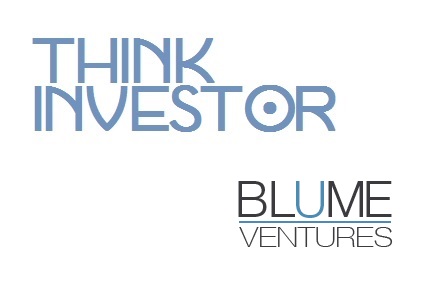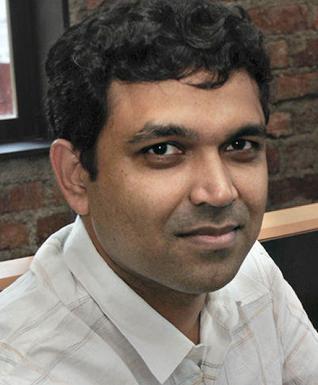ThinkInvestor is iSPIRT and ProductNation’s new initiative to serve as a catalyst between Venture Capital firms, Angels, Angel Networks and Entrepreneurs. It is to go beyond brochure ware and dig deeper into the whole life cycle of a typical investment; from introductions, funding, styles of on-going engagement, to exits. And in the process, capture their views on global and local trends, and the entrepreneurial ecosystem in India.
 Blume Ventures is an early-stage seed & pre-series A venture fund based out of Mumbai, India. They provide seed funding in the range of $50K – $300K to early-stage tech-focused and tech-enabled ventures. They are proponents of a collaborative approach and like to co-invest with like-minded angels and seed funds. They then provide follow-on investments to stellar portfolio companies, ranging from $500K – $1.5 million.
Blume Ventures is an early-stage seed & pre-series A venture fund based out of Mumbai, India. They provide seed funding in the range of $50K – $300K to early-stage tech-focused and tech-enabled ventures. They are proponents of a collaborative approach and like to co-invest with like-minded angels and seed funds. They then provide follow-on investments to stellar portfolio companies, ranging from $500K – $1.5 million.
ProductNation sat down with Karthik Reddy, Managing Partner, Blume Ventures for this interview. Here ‘s what we heard:
What made you focus on early stage investing in India? And your observations of this market?
 Adoption of innovative technologies has always been a challenge in India. Early on we realized that growth has to come from other global markets like the US or Europe. We also realized that there was a huge gap in the venture market in India for investments between $150K and $3M. Our intention in our first fund was to bridge these gaps. They proved to be larger than what we thought initially. The venture market at the top of the funnel (late stage) was very wide, the middle had also widened but the lower end offered opportunities for us. But this market has its own problems – bridging the gap between this level of funding and the next stage. Series A funding of companies has been a continuing problem but we have found ways to bridge these gaps. However, with our next fund to be raised next year, we plan to stick to the same strategy, but with a larger fund.
Adoption of innovative technologies has always been a challenge in India. Early on we realized that growth has to come from other global markets like the US or Europe. We also realized that there was a huge gap in the venture market in India for investments between $150K and $3M. Our intention in our first fund was to bridge these gaps. They proved to be larger than what we thought initially. The venture market at the top of the funnel (late stage) was very wide, the middle had also widened but the lower end offered opportunities for us. But this market has its own problems – bridging the gap between this level of funding and the next stage. Series A funding of companies has been a continuing problem but we have found ways to bridge these gaps. However, with our next fund to be raised next year, we plan to stick to the same strategy, but with a larger fund.
What has been the effect of exits like redBus.In on the Indian ecosystem? Do you think that this improves the outlook for more early stage investing?
Yes. Exits like redBus.in are good for various things in the Indian ecosystem. If not for the individual exit, more examples like redBus are needed sorely. Typically, companies like those take around 8 years to enter, and exit. The public markets are not good options as yet for exits. We do not as yet have a culture of acquisitions within India. Indian companies don’t do them. Companies like Naukri should really consider acquisitions and grow inorganically. Large companies in the US are beginning to take notice of possible acquisitions in India and have started doing some cross-border transactions. This kind of ecosystem did not exist but things are beginning to change. We still have a huge need for innovative ideas. Ideas that can get built into $40M to $50M companies and get exits are key to putting the ecosystem into higher gear.
How does an entrepreneur get your attention? What kinds of start-ups interest you? How does an entrepreneur get in touch with you?
We are driven by themes. We are not reactive investors. We are interested in Smartphone/Mobile plays and are not interested in web applications. If we see a plan first addressing a web version of an application we are not interested, but those that go straight to a mobile app will get our attention. Our themes are chosen so that they can grow fast and get to a Series A comfortably. The entrepreneur needs to think like a VC and ensure that whatever they are working on is capable of such growth. Founders of our portfolio companies know our themes best. Get in touch with them, see if there is a mapping between what you do, and what we are interested in. Get one of the founders to introduce you to us after this initial filtering. This way, you won’t waste your time and you will get our attention! We do get cold referrals that go through our associates and it will be a long winded process. If you come through the founders of our portfolio companies it will be faster and it can also make sure that there is a mapping between what you are thinking and what our investment themes are. We get 60 to 70% of the introductions like this, with 125+ founders in our portfolio network.
Let’s say there is a mapping between a start-up company and your VC firm. What happens next? What are your typical due diligence efforts? How long does it take for an investment?
We are primarily looking for leadership in these companies that can survive the long haul of entrepreneurship. Can they survive the first year of marriage, primarily between the co-founders? Do they have 2 to 3 layers of leadership in the start-up, not just a single layer with the co-founders! And are the co-founders super-compatible with each other? We have seen too many founder breakups! We are not looking for problem solvers – people who solve a problem with a technical solution. We are looking for business builders. Can they build a business around it? They are not the same! In 1 or 2 meetings (in 2 or 3 weeks) you can get an idea of whether we want to proceed ahead with due diligence or let you know that the fit between our themes and your business is not there. If you can find co-investors on your own is a positive thing in your favor. The ability to excite other investors is key to us. The ability to line up other clients or customers during this period is important to us. We look for some red flags during the due diligence period – like being very casual about relationships or client opportunities. The fastest investments have been made in 4 to 5 months from introductions. The slowest ones have taken 12 to 18 months. The latter ones are usually because of syndicated investments.
Let’s say a start-up gets funded by you. How hands-on or hands-off are you with your portfolio company? What’s your style of engagement with a portfolio company?
Portfolio companies should consider us a Super-Concierge on Demand. They should be comfortable with knowing exactly when we are needed and come to us. In the early stages they come to us with quite a few problems for advice and guidance. Luckily our founder network usually has many of the answers. We have a Google group for our portfolio company, sort of a private Quora. This helps solve 70 to 80% of the problems our start-ups face. Someone has come across most of the problems any new portfolio company is facing. Typically these will be questions like whether to incorporate in the US or not. We are more like a platform than a VC firm in that sense, an 18-24 month accelerator program. We are as hands-on or hands-off with companies as needed. We do take a board seat as a seed investor and invariably meet with each portfolio company in person, at least every couple of months.
Let’s talk about going beyond the early stage funding and getting to the next level of funding and growth.
Series A funding is becoming more difficult with the bar being set higher and higher. There are only 10 to 12 active Series A investors in India doing 1 or 2 investments a year. With such a thin ecosystem for Series A investing, pitching the wrong partner may mean not getting funded. The other problem is making these businesses 10X propositions for Series A (they are not interested in 5X business plans) that require these companies to become $200M companies. We do bridge rounds that can get start-ups to get the growth necessary to qualify for a Series A funding. We are planning to raise a larger fund next time so that we can make these kinds of deeper investments.
Do you think it is possible to build a $200M company focused on the Indian market?
Yes. There are some promising areas in India that has that potential – travel or taxi services. Technology solutions like Knowlarity, NowFloats, and Exotel have that potential. The Enterprise market in India is too slow but the SME market in India has the potential to build some $200M companies. That market will also explode only when the smartphone/mobile market in India leapfrogs. The SaaS market, especially when built for a global market could grow a few $200M companies. We are optimistic overall and feel that lots of opportunities are yet to come.
Now, let’s talk about Exits. What do you see coming in this area?
The subject of realistic venture exits is the one that somewhat dictates what the focus of a start-up should have been. Hoping to get acquired by a company in India is somewhat unrealistic. However, there are a number of companies in the US that have started coming to India to acquire Indian companies and grow inorganically. Autodesk is hiring a person in India to look for such companies, They have done a number of acquisitions already. Unfortunately, the Indian arms of Google and Yahoo are not empowered to make acquisitions.There are some companies like WebEngage and OrangeScape that are focused on foreign markets that could make good acquisition targets for companies outside India.
What about some parting advice for entrepreneurs?
Go outside India for markets. You cannot grow fast enough to raise funding and grow focusing on Indian markets currently. This is true especially if you are a technology play. Someone in Silicon Valley could start 2 years later than a company in India and beat them to it if a company is growing only in India. Grow fast and get acquired!













